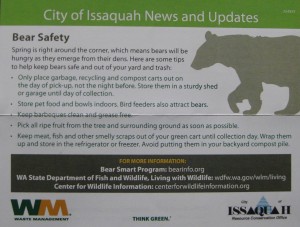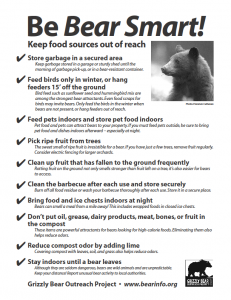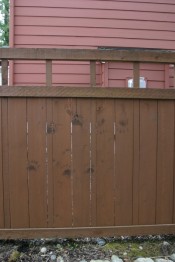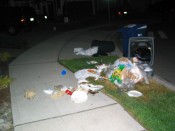Press Contact:
Donald Lee, WNET
212.560.3005, LeeD@wnet.org
Press Materials: pbs.org/pressroom or thirteen.org/pressroom
Facebook: facebook/PBSNature Twitter: @PBSNature
Get up close and personal with North American bears in
THIRTEEN’s Nature’s three-part special
Bears of the Last Frontier, beginning May 8, 2011 on PBS
Join the wildlife community and watch episodes at pbs.org/nature
Bears are an ultimate icon of the wild, regarded as among the most successful wild animals on the planet. Three of the eight bear species in the world – brown bears, black bears, and polar bears –can be found in Alaska, one of North America’s last truly wild frontiers. Nature joins adventurer and bear biologist Chris Morgan on a year-long motorcycle odyssey deep into Alaska’s bear country to explore the amazing resiliency and adaptability of these majestic animals as they struggle to make a living in five dramatically diverse Alaskan ecosystems: coastal, urban, mountain, tundra, and pack ice. Bears of the Last Frontier, a special three-part series, premieres on three consecutive Sundays, beginning May 8, 2011 at 8 p.m. (ET) on PBS (check local listings). After broadcast, the programs will stream at pbs.org/nature. A companion book documenting the epic journey and the making of the film will be released by Stewart, Tabori & Chang, an imprint of ABRAMS in April 2011.
Currently in its 29th Season, Nature is a production of THIRTEEN in association with WNET – one of America’s most prolific and respected public media providers.
“There’s a constant tension filming bears on their turf,” said Fred Kaufman, Series Executive Producer. “Nature is pleased to have Chris Morgan as our guide into this unknown territory where anything can happen. His journey into the world of the bears features mesmerizing spontaneous interactions with them that can be both suspenseful and captivating. He allows us to get a look at the candid behavior of bears being bears in their natural surroundings.” Traveling with a small film crew whose inclusion in the series creates a behind-the-scenes feel throughout, Morgan immerses himself completely in the bears’ world to give us an astonishingly intimate portrait of North American bears. Over the course of a 3,000 mile journey that includes the Alaska Peninsula, Anchorage, Denali, Brooks Range, Kaktovik, and Barrow, Morgan reveals bears as curious individuals with unique personalities. They are complex socials animals with lives that are extremely vulnerable to habitat encroachment and climate change.
From lush forests to icy Arctic, Bears of the Last Frontier captures the allure of the wild symbolized by these remarkable creatures. Over the course of three episodes, the film reveals survival strategies of each of the three bear species.
Part 1 – City of Bears
Chris Morgan sets up camp at a remote spot in the heart of Alaskan wilderness, alongside the largest concentration of grizzlies in the world. It is June in the Alaska Peninsula. The sun sets well into night and bears are taking advantage of the long days to feed, mate, and raise new cubs. Morgan tracks their progress as they feast on the riches of the season and re-establish the complex hierarchal social dynamics of bear society. Along the way, he experiences close encounters with bears, observing brutal battles among males during mating season as well as tender moments between a grizzly mom and her cubs.
Part 2 – The Road North
The second hour explores the world of black bears caught in the crossroads of urban development in Anchorage and the wilderness. This is a new normal for bears and for their human neighbors. Some bears are so comfortable living in urban surroundings that their primary habitat is a golf course. In residential areas, bears frequently raid garbage bins and birdfeeders for easy snacks. But these behaviors are less than ideal for bears and residents alike. Morgan heads north out of Anchorage to Denali National Park, where the mountains loom over treeless plains and bears get by on a diet of thousands of berries a day. The grizzlies share the enormous park with foxes, wolves, and moose — and with one intrepid bear biologist and his team. Morgan continues his journey north on a bone-shaking 610-mile motorcycle journey from Denali to Prudhoe Bay along the only Alaskan Highway to reach the Arctic. Prudhoe Bay, a once- pristine area at the edge of the Arctic Ocean, has been changed forever by the oil industry.
Part 3 – Arctic Wanderers
In the final hour, Chris Morgan travels to the far north of Alaska, the tiny North Slope town of Kaktovik. It’s early November and winter is coming on. But each year, the polar bears struggle for extended periods on dwindling fat reserves, waiting for the opportunity to hunt on sea ice that takes longer to freeze. In early spring, Morgan joins local hunters in Barrow, the northernmost city in Alaska, as they go out on their own hunts, facing some of the same challenges as the bears. In late spring, Morgan travels to the North Slope of the Brooks Range, where countless thousands of caribou cover the ground for miles. The grizzlies are waiting for them, as they have for thousands of years.
Nature’s Bears of the Last Frontier is a production of Pontecorvo Productions and THIRTEEN in association with Wildlife Media, National Geographic Channel and WNET. Written and Produced by Joe Pontecorvo. Nature is a production of THIRTEEN in association with WNET for PBS. Fred Kaufman is Executive Producer. William Grant is Executive-in-Charge.
Nature pioneered a television genre that is now widely emulated in the broadcast industry. Throughout the series’ history, Nature has brought the natural world into the homes of millions of viewers. The series has been consistently among the most-watched primetime series on public television.
Nature has won nearly 600 honors from the television industry, the international wildlife film communities, and environmental organizations – including 10 Emmys, three Peabodys and the first award given to a television program by the Sierra Club. In October of 2010, the series won the Christopher Parsons Outstanding Achievement Award, given to “an organization or individual that has made a globally significant contribution to wildlife filmmaking, conservation and/or the public’s understanding of the environment.” The award, given by the Wildscreen Festival in Bristol, England, is one of the wildlife film industry’s highest honors.
PBS.org/nature is the award-winning web companion to Nature featuring streaming episodes, teacher’s guides and more.
Major corporate support for Nature is provided by Canon U.S.A., Inc. Additional support is provided by the Lillian Goldman Charitable Trust, by the Corporation for Public Broadcasting, and by the nation’s public television stations.
About WNET
New York public media company WNET is a pioneering provider of television and web content. The parent of THIRTEEN, WLIW21 and Creative News Group, WNET brings such acclaimed broadcast series and websites as Tavis Smiley, Need To Know, Nature, Great Performances, American Masters, Charlie Rose, Secrets of the Dead, Religion & Ethics Newsweekly, Visions, Consuelo Mack WealthTrack, Miffy and Friends, Angelina Ballerina: The Next Steps and Cyberchase to national and international audiences. Through its wide range of channels and platforms, WNET serves the entire New York City metro area with unique local productions, broadcasts and innovative educational and cultural projects. In all that it does, WNET pursues a single, overarching goal – to create media experiences of lasting significance for New York, America and the world. For more information, visit www.wnet.org




